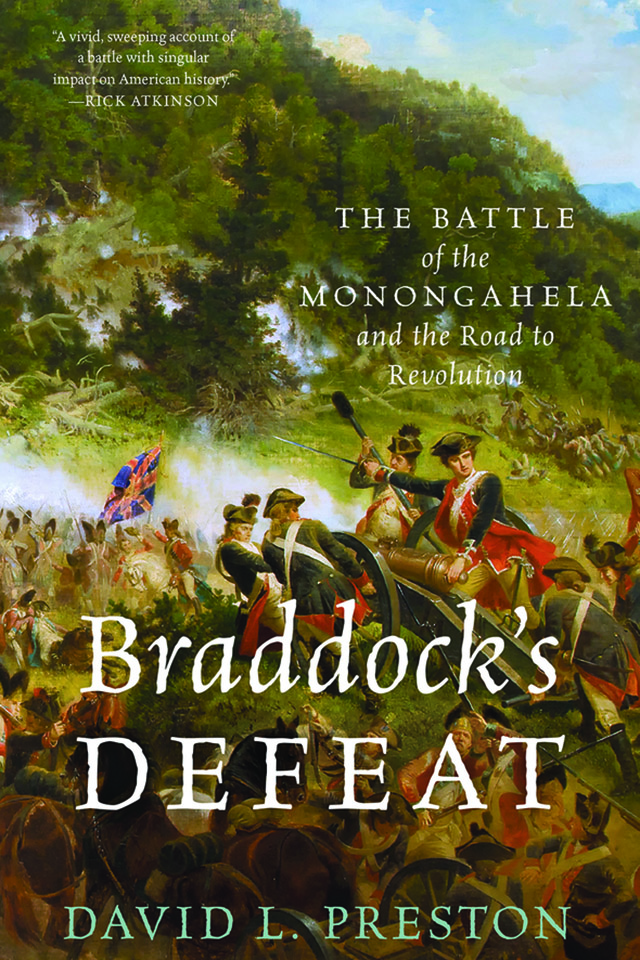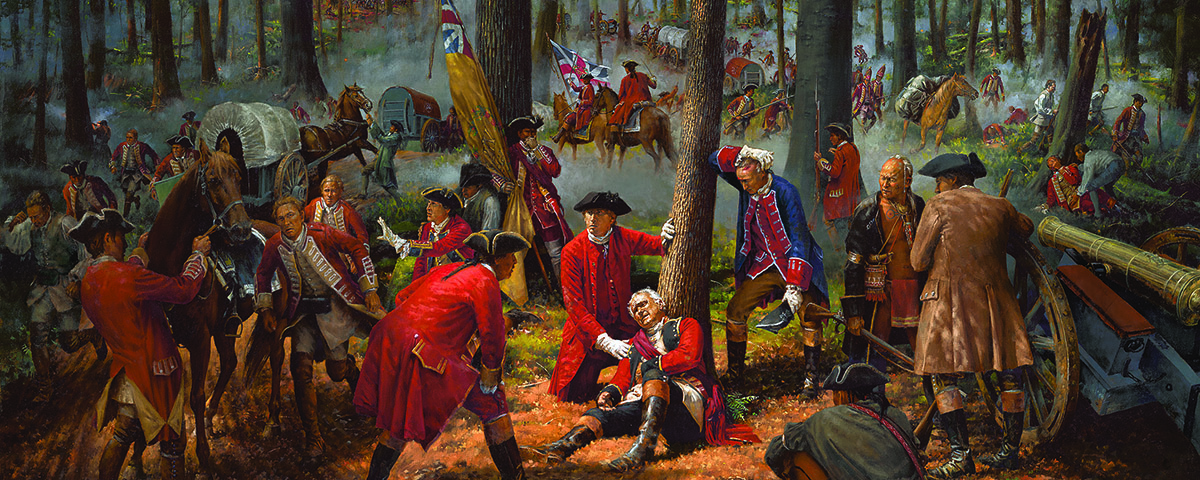Colonial discontent, font of revolutions, contributed to 1755 British defeat at Fort Duquesne
GENERAL EDWARD BRADDOCK’S defeat in 1755 by an allied French and Indian force outside Fort Duquesne—now Pittsburgh—recast the French and Indian War. In Braddock’s Defeat, historian David L. Preston argues that the battle and its consequences escalated that conflict between Britain and France into a global struggle known as the Seven Years’ War, opening fissures between Britain and the 13 colonies that helped bring on the American Revolution. The destruction of a conventional British army by irregular forces in remote mountainous territory foreshadows similar encounters in the 18th, 19th, 20th, and 21st centuries.
How did the Seven Years’ War play out in North America? New France, which reached from the Gulf of St. Lawrence to the Gulf
of Mexico, was the strategically dominant power in the region in the mid-1700s. In
contrast to Britain’s more populous and expansive colonies, New France had a meager population that depended heavily on the fur trade. To conduct that trade, the French relied on neighboring Indian tribes. The Indians’ desire for sovereignty led them to collaborate militarily with New France in its effort to contain the westward expansion of British colonies like Virginia.
In 1755, what made the Forks of the Ohio so important? Interior waterways afforded the fastest, most reliable routes into and around the continent’s interior. Control of the Forks of the Ohio, where the Allegheny and Monongahela Rivers form the Ohio River, enabled British traders to compete with French counterparts and, in so doing, to challenge New France’s network of Indian alliances. The French built forts to keep the British out of the Ohio Valley. But aggressive British colonies like Virginia were determined to assert claims to the disputed region.
The British mistrusted colonial officers like George Washington. Washington came to the fore in this dispute among France, Britain, and Indian nations over the Ohio Valley. As lieutenant colonel of the Virginia provincial regiment, Washington had led early British military ventures against the French, notably a humiliating defeat at Fort Necessity in 1754. When London learned of that loss, the British government sent regular troops under royal officers to salvage the situation. Braddock asked Washington to serve in his expedition, but only as a gentleman aide, not an officer with rank. Imagine the difference in Washington’s life—and American history—had the British government decided to recruit patriotic British Americans into royal regiments officered by colonists like Washington.
British regulars had no experience with Indian-style warfare. In the 1740s, Braddock’s 44th and 48th infantry regiments had fought

By David L. Preston
Oxford University, 2015, $17.95
conventional battles in Scotland and Europe, but nothing had prepared them for combat in the mountains against small, dispersed, and highly skilled units of French Canadians and Indian warriors using irregular tactics, such as firing from cover. Contrary to mythology, General Braddock had taken adequate precautions, deploying as many as a third of his 1,400 men as flankers on his column’s outer edges. In the end, 250 French and Canadian troops and 600 to 700 Indian warriors showed more discipline than British regulars—using natural cover, accurate musketry, and individual initiative—to destroy Braddock’s flank protection and kill or wound two British soldiers in three who crossed the Monongahela. Superior French and Indian tactics destroyed the ring of security. The British massed together, leaving themselves no option but to run for their lives or die where they stood.
How did tensions between Braddock’s army and colonists shape the expedition? There is much evidence of political and social conflict between the Americans and the British Empire, personified in Braddock and his army. Historically, Britons feared standing armies as threats to their political liberties and economic wherewithal. Once Braddock and his force landed in Virginia, conflict quickly ensued with various colonial governments over supplying, quartering, recruiting, and financing Braddock’s and other British forces in America. The 1755 campaign rudely awakened British authorities to the growing political independence of the 13 colonies.
Why was funding an issue? The British had expected colonial legislatures to supply Braddock’s expedition and to vote public monies to a common fund for defense to be controlled by Braddock, who was commander in chief of British forces in America. The American legislatures balked at the costs and often refused to surrender control of public monies. Braddock and other British officers blamed the expedition’s delays on the uncooperative colonial governments.
So what? Braddock and other British commanders sent report after report to London calling the colonies uncooperative, unpatriotic, and even disloyal. The colonies contributed enormous sums of money and manpower to British victory in the war, but many London politicians developed an idée fixe of Americans as ungrateful. After the war, Parliament directly taxed colonists, to make them partially responsible for funding their own defense, and to lessen their political independence.
The French operated differently. By the 1750s, French colonists had been in the New World for generations and identified as Canadians. Elite French Canadians often became commissioned officers in the French military and through decades of service at far-flung locations around New France gained noble status or royal preferment. They dealt intimately with Indian allies, learning their languages and cultures. Most important, those French soldiers learned the Indian way of war. Braddock’s French opponent, Captain Daniel-Hyacinthe-Marie Liénard de Beaujeu, was a veteran of irregular combat. He knew how to negotiate with Indian allies comprising two-thirds of his force.
What is the lesson of Braddock’s defeat? Braddock’s defeat, in its time and in history, shows a confident conventional army coming to naught against an unconventional force in a foreign environment many British soldiers found terrifying. It also shows how armies as institutions often unlearn hard-fought lessons. In 1775, the British army suffered a shocking defeat at the Battle of Concord, a running action that many compared to Braddock’s defeat 20 years earlier. And in turn, Native American warriors in the Northwest Territories decisively defeated U.S. Army forces at the Battle of the Wabash in 1791—St. Clair’s Defeat—and in the Montana Territory at the Little Bighorn in 1876—Custer’s Last Stand. As the United States continues military operations in Iraq, Syria, and Afghanistan, Braddock’s defeat testifies to the importance of understanding tribal polities and the worlds they frame.





